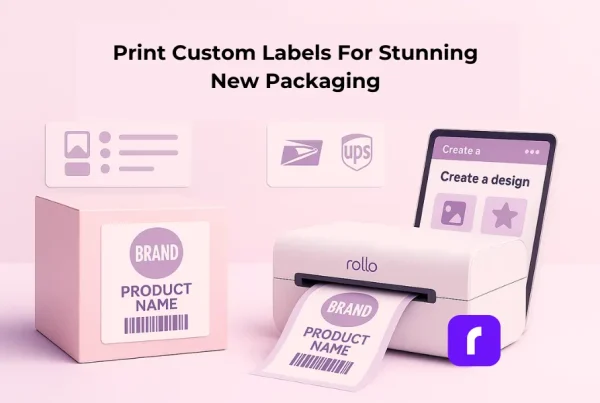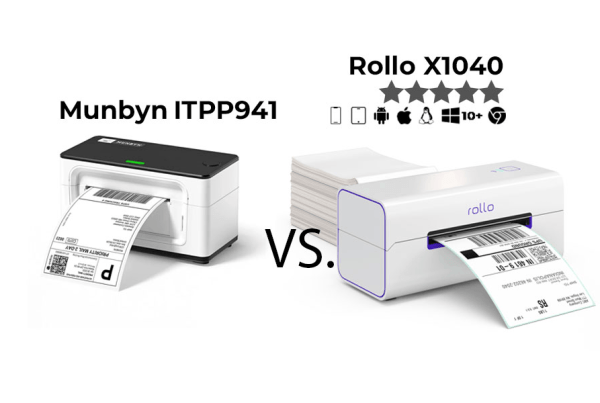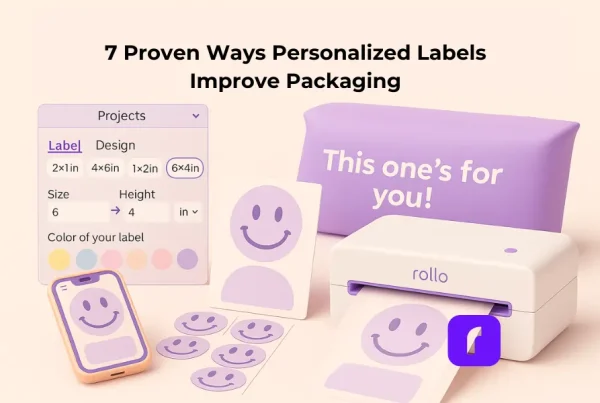Ecommerce shipping is the process of delivering online store orders to customers using shipping carriers, methods, and software. An optimized ecommerce shipping strategy can lower shipping costs by up to 30%, improve delivery speed, and boost customer satisfaction through multiple shipping options and clear delivery expectations.
Picture this: It’s 9:47 at night, and you finally sit down after a long day of packing orders. You look at the stack of boxes ready to go and feel relieved—until you notice one label is crooked and another package has the wrong zip code. Just like that, your relaxing evening turns into a rush to fix the mistakes before the morning pickup. The right e-commerce shipping solutions not only prevent costly errors but also streamline your fulfillment process from label printing to delivery tracking.
Table of Contents
If you run an online store, you know ecommerce shipping can make or break your business. Customers don’t just want their orders—they want them on time, in perfect shape, and without any surprise fees or slow tracking updates. Even small mistakes in your shipping process can cost you money, waste your time, and make customers less likely to order again.
In this guide, we’ll walk you through 10 common ecommerce shipping mistakes that even experienced sellers make—and how to avoid them. From picking the wrong carrier to paying too much for labels, you’ll get simple tips that can save you money, speed up your shipping, and keep your customers happy.
Mistake #1 – Choosing the Wrong Shipping Carrier
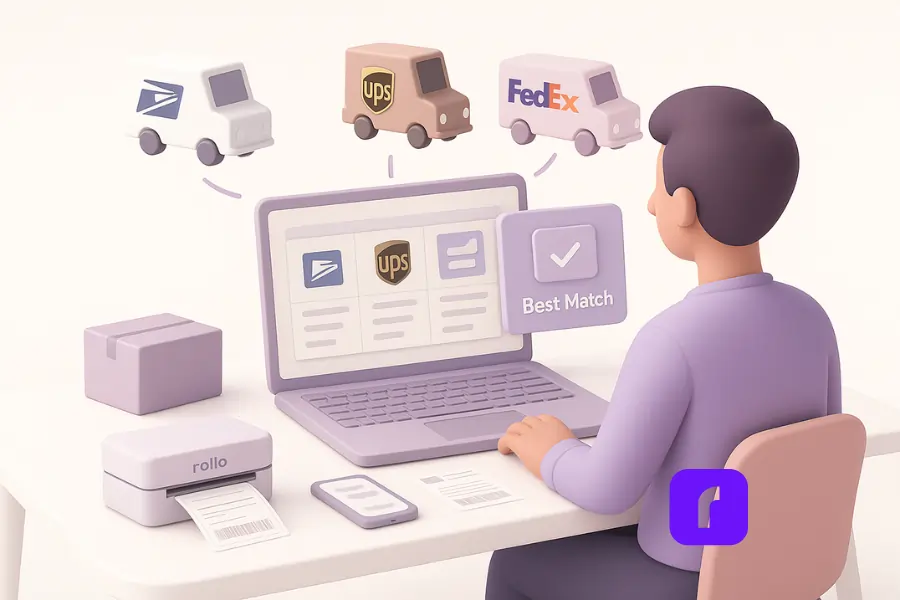
Picking the wrong shipping carrier raises costs, slows delivery, and hurts customer satisfaction. In ecommerce shipping, shoppers abandon carts over high extra costs and slow delivery, so carrier choice matters. Partnering with reliable ecommerce shipping companies like USPS, UPS, and FedEx ensures your packages arrive on time and at the best rates. Compare price, speed, reliability, coverage, and tracking. Mix national and regional carriers with a multi-carrier tool like Rollo Ship to optimize each order.
Why the Right Carrier Choice Matters
Your carrier affects shipping costs, delivery speed, and reviews. According to 2024 Baymard Institute data cited by Shopify, extra costs cause 48% of cart abandonment, while slow delivery causes 23%. Reliability and on-time delivery drive satisfaction more than raw speed. Meet your promised window, and you’ll keep buyers coming back.
Not sure which carrier is best for your store? Compare your options in our breakdown of UPS vs USPS for eCommerce shipping.
Common Carrier Selection Mistakes
Many sellers choose only by price. Others ignore tracking quality, fees, or delivery performance. Some overlook regional carriers that often offer lower rates in specific zones. That leaves money on the table and raises risk during peak season.
How to Choose the Best Carrier for Your Business
Compare carriers on five factors:
- 💲 Rates and surcharges (total landed cost)
- ⏱️ Transit time to key zones
- 🗺️ Coverage area and pickup reliability
- 📦 Tracking quality and notifications
- 🛠️ Claims and support
Rollo Ship ranks among the best ecommerce shipping solutions for small businesses thanks to its pay-per-label model and carrier discounts. Use Rollo Ship to rate-shop across carriers for every order. Blend national and regional options to cut ecommerce shipping costs while protecting on-time delivery.
🚀 With Rollo Ship, you can instantly compare USPS, UPS, and more — ensuring you always choose the cheapest, fastest, or most reliable option for each order.
Mistake #2 – Ignoring Dimensional Weight Pricing
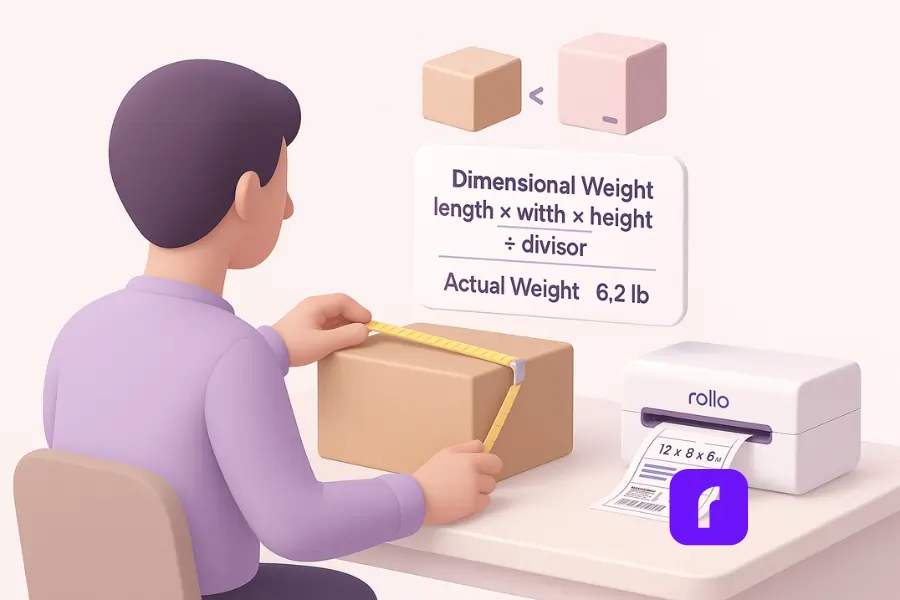
Dimensional weight charges you for package size, not just scale weight. In ecommerce shipping, a big but light box can cost more than a small heavy one. Carriers bill the higher of actual or dimensional weight. Right-size boxes, measure accurately, and print labels with correct dimensions to avoid surprise fees.
What Is Dimensional Weight?
Dimensional weight (DIM) is volume-based pricing. Carriers multiply length × width × height, then divide by a set divisor. They compare this number to actual weight and bill the higher amount. FedEx and UPS commonly use a 139 divisor; USPS uses 166 in many cases.
How It Impacts Ecommerce Shipping Costs
Large, lightweight packages often trigger DIM charges. That means higher ecommerce shipping costs than you expected. USPS applies DIM when a package exceeds one cubic foot and may add a dimension-noncompliance fee if sizes are missing or wrong.
How to Avoid Paying More Than You Should
Right-size your packaging and avoid empty space. Measure every box and enter dimensions before buying labels. Rollo Ship captures exact dimensions on label creation, helping prevent adjustments and fees. For USPS Ground Advantage, remember DIM applies over one cubic foot; for FedEx and UPS, plan around the 139 divisor.
Mistake #3 – Not Offering Enough Ecommerce Shipping Options
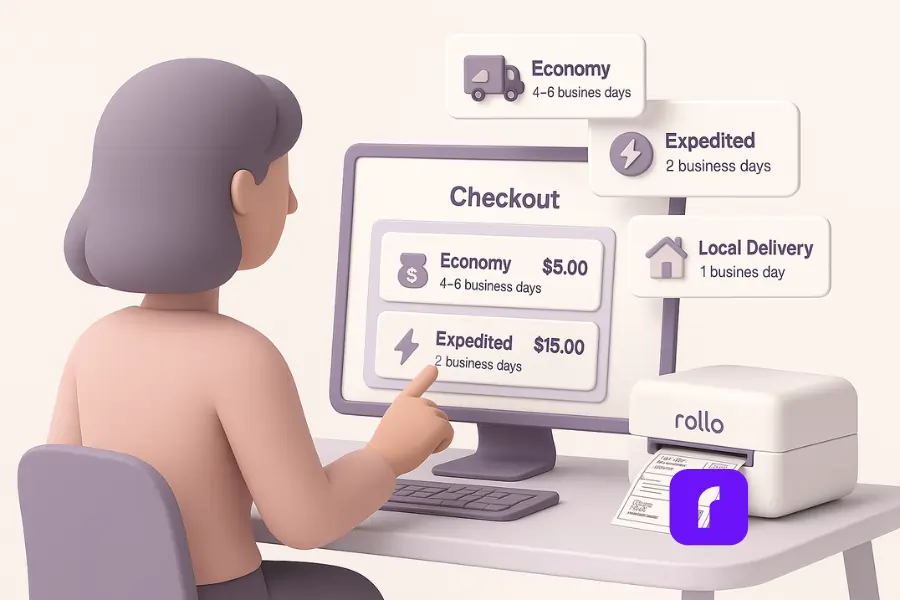
Too few shipping options cost you sales. In ecommerce shipping, customers want choice on price and speed. Many will wait two to three days if shipping is free, but they still expect flexible methods at checkout. Offer economy, expedited, same-day, and local delivery to match different needs and budgets.
Why Multiple Options Matter to Customers
Choice reduces cart anxiety and boosts customer satisfaction. Most shoppers accept two–three day delivery when it’s free, but not everyone wants the same pace. Clear ecommerce shipping options help buyers pick the best tradeoff for cost and time.
Common Gaps in Shipping Choices
Many stores show only “standard shipping.” That ignores buyers who need faster service or a cheaper economy option. Some checkouts also hide delivery dates, which causes hesitation and drop-offs.
How to Expand Your Ecommerce Shipping Methods
Offer a balanced menu:
- 💵 Economy/flat-rate for price-sensitive orders.
- 🚀 Expedited or same-day for urgent gifts.
- 🏠 Local delivery or pickup where it makes sense.
Use Rollo Ship to manage multiple ecommerce shipping methods in one dashboard and surface best-fit carriers per order. Showing clear delivery dates at checkout can also reduce abandonment.
Mistake #4 – Overpaying for Shipping Labels
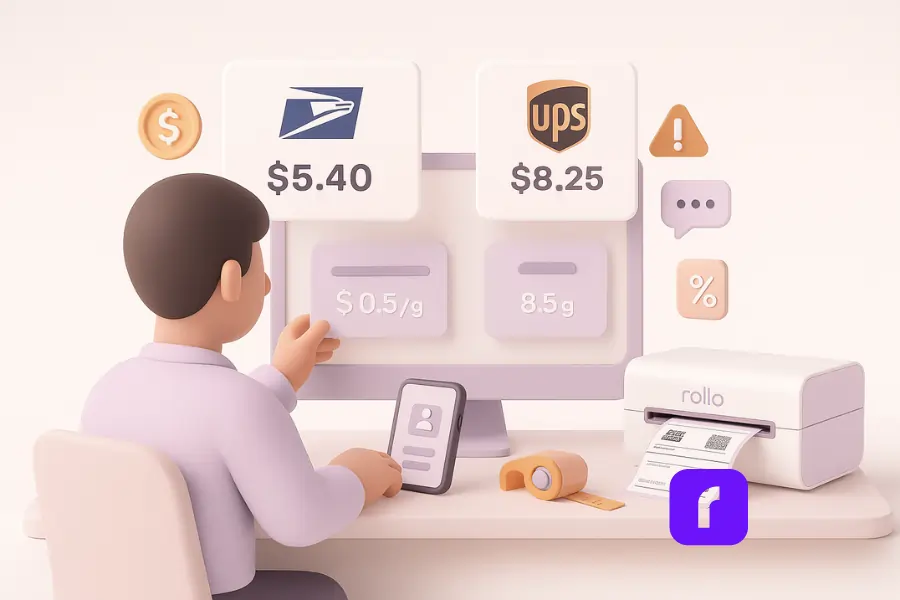
Label costs sneak up fast. Many sellers pay retail rates or get hit with adjustments and surcharges. Use commercial USPS rates and negotiated UPS discounts to lower your ecommerce shipping bill. Enter exact dimensions to avoid penalty fees. Multi-carrier tools like Rollo Ship help you pick the cheapest valid label every time.
Why Label Costs Add Up Fast
A few extra cents per label becomes hundreds over a month. Paying retail instead of commercial pricing multiplies that gap. Extra fees and seasonal surcharges raise the total even more.
Common Reasons for Overpaying
- 🏷️ Buying labels at retail instead of lower Commercial Rates.
- 📏 Entering wrong dimensions, which triggers dimension-noncompliance adjustments.
- ⚠️ Missing hidden costs like additional handling or address correction fees.
How to Get Discounted Rates
- 📮 Ship online with USPS to access Commercial Rates; businesses can save more via the Business Rate Card.
- 📦 Create a UPS account to get instant negotiated discounts for small businesses.
- 🔍 Use Rollo Ship to compare carriers and surface the lowest compliant label.
- 📐 Always measure and enter exact dimensions before buying. This prevents adjustments and keeps ecommerce shipping costs predictable.
These savings grow when your box actually fits. Next, we’ll fix packaging choices that quietly raise costs and returns.
🚀 Pair accurate measurements with the Rollo Wireless Label Printer for fast, ink-free label printing from anywhere in your workspace.
Mistake #5 – Poor Packaging Choices
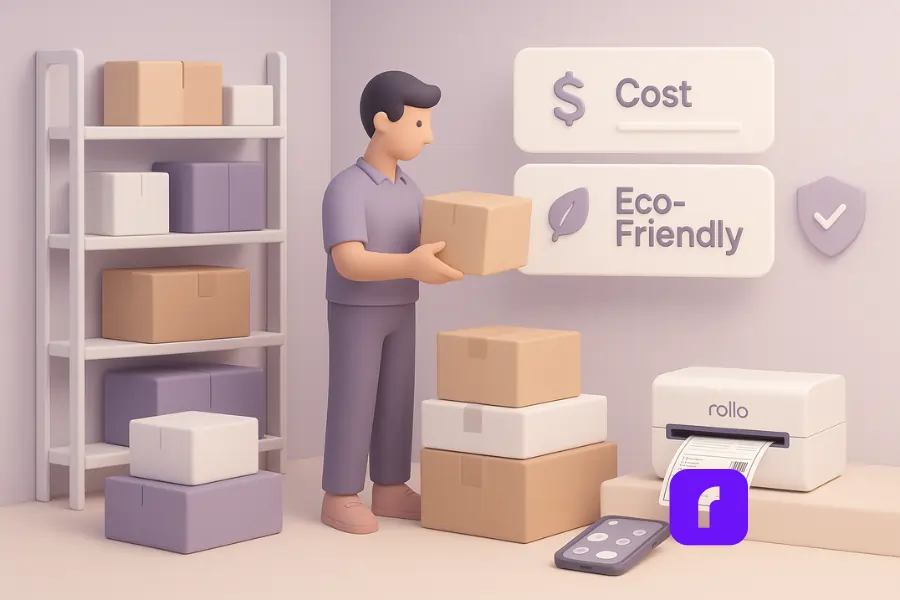
Packaging drives both cost and customer satisfaction. Oversized boxes raise shipping costs through dimensional weight pricing. Weak materials increase damage and returns. Right-sized, durable, and eco-friendly packaging lowers fees and protects orders. It also signals care for the planet, which many shoppers value today.
How Packaging Affects Cost and Safety
Big boxes cost more because carriers price by size as well as weight. That’s dimensional weight. Smaller, tighter boxes reduce fees. Weak boxes and poor cushioning lead to breakage. Damaged items drive returns and hurt customer satisfaction. Shopify reports “damaged or defective” as a top return reason.
Common Packaging Mistakes
- 📦 One-size-fits-all boxes that add empty space
- 🫧 Thin mailers for fragile items
- 🌱 Skipping eco-friendly choices when buyers value them
These miss easy savings and send the wrong brand message. Many consumers will pay more for sustainable packaging.
How to Improve Your Packaging Strategy
Right-size every order. Keep multiple box sizes and measure before buying labels to avoid DIM surprises. Use sturdy materials and smart cushioning. For eco-friendly ecommerce shipping, pair recycled or compostable mailers with Rollo’s FSC-certified, BPA-free thermal labels for clean barcodes and a greener unboxing. This sets up the next step: clearer delivery promises and tracking that keep customers informed.
Mistake #6 – Not Communicating Delivery Times Clearly
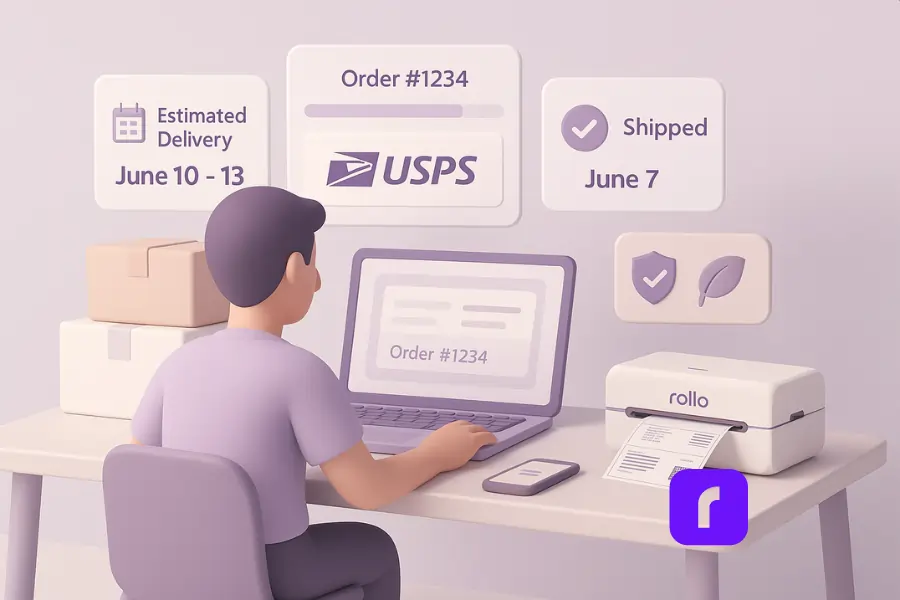
Clear delivery times build trust and boost conversions. In ecommerce shipping, shoppers want an estimated date at checkout and updates after purchase. Vague timelines raise cart abandonment and support tickets. Show a date range, note cutoff times, and send real-time tracking. Keep customers informed from order to doorstep for higher satisfaction.
Why Delivery Transparency Builds Trust
When buyers see a clear ETA, they feel in control. Baymard Institute reports unclear shipping info is a top checkout friction that hurts conversion. Post-purchase, most shoppers expect regular tracking updates, not just a receipt, which keeps confidence high and reduces “Where is my order?” messages.
Common Communication Failures
- ⏳ No estimated delivery date at checkout
- 📅 “3–7 business days” instead of a real date range
- 🕒 Missing order cutoff and processing times
- 📧 Generic tracking emails with little detail
How to Set Clear Expectations
Show a date range at checkout, based on processing plus transit time. Display the shipping method and carrier, like USPS Ground Advantage or UPS 2nd Day Air.
- 🕰️ Add order cutoff times by timezone
- 📲 Send proactive tracking notifications after each scan
- 🌐 Use a branded tracking page with status and FAQs
- ⚙️ Automate updates with Rollo Ship to keep customers informed
Mistake #7 – Failing to Track and Measure Shipping Performance
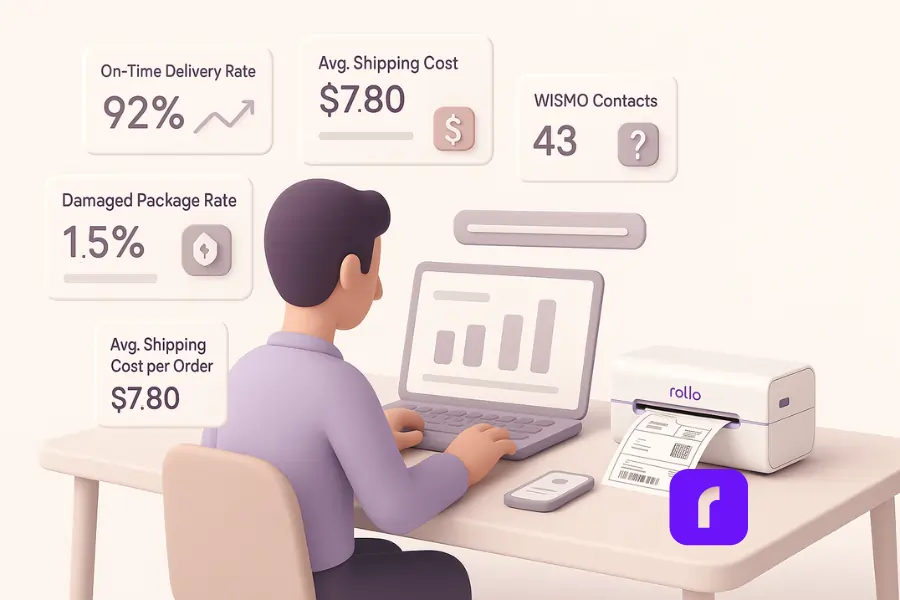
If you don’t track results, you can’t improve ecommerce shipping. Measure on-time delivery, damage rate, and average shipping cost per order. Watch WISMO (“Where is my order?”) volume, too—it can drive a big share of support contacts. Use dashboards to spot trends and fix weak links fast.
Why Tracking Your Metrics Matters
Metrics reveal where money and time leak out of your ecommerce shipping process. Better on-time delivery lifts revenue and customer satisfaction, while delays do the opposite. Consistent tracking turns guesswork into clear actions.
Metrics You Should Monitor
- ⏱️ On-time delivery rate: Percent of orders delivered by the promised date.
- 📦 Damaged package rate: Percent of orders arriving broken or unusable.
- 💲 Average shipping cost per order: Total shipping spend divided by total orders.
- ❓ WISMO contacts: Share of support tickets asking about order status.
These KPIs are standard for leading ecommerce operations.
How to Use This Data to Improve
Rank shipping carriers by lane and switch from poor performers. Reduce damage with tighter packaging and better materials. Automate reporting with Rollo Ship’s dashboard to compare trends over time and cut avoidable costs fast.
Mistake #8 – Not Preparing for International Orders
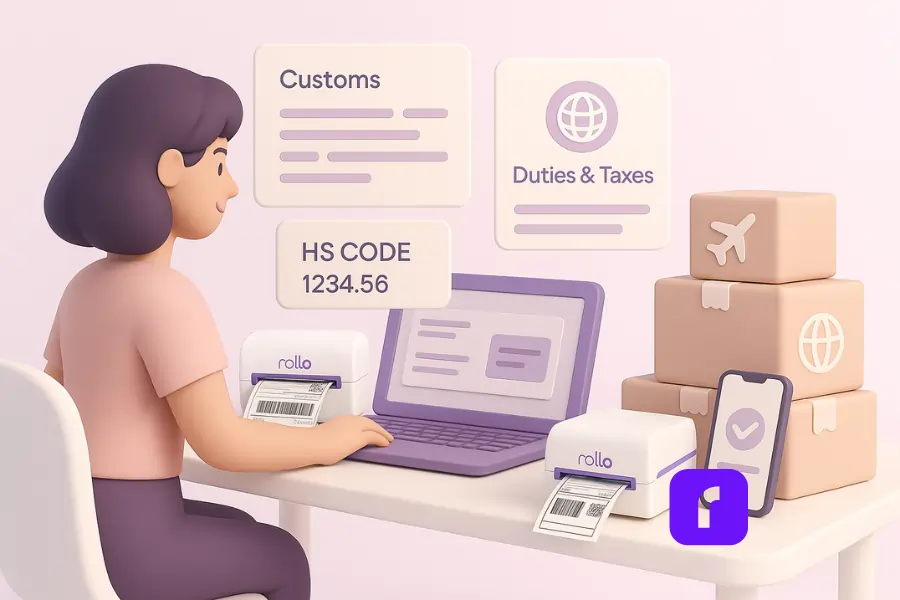
International ecommerce shipping is more complex than domestic. You must handle customs forms, duties, taxes, and longer transit times. Missing details causes delays, returns, and unhappy customers. Plan for documents, accurate HS codes, and clear delivery expectations. Use tools that create customs-ready labels and real-time tracking to avoid surprises.
Why International Shipping Is Different
Every country has its own rules, taxes, and restricted items. Carriers also follow different service levels and delivery timelines. Small mistakes can trigger inspections, storage fees, or returns to sender.
Common International Shipping Mistakes
- 📄 Skipping or mis-filling customs forms
- 📝 Using vague product descriptions or wrong HS codes
- 💰 Understating value to dodge duties
- 🏛️ Ignoring VAT and import tax requirements
- 🚚 Not offering door-to-door tracking or insurance
How to Ship Internationally with Fewer Hassles
- Create customs-ready labels with precise item descriptions and HS codes.
- Declare true value and list currency to prevent holds and fines.
- Set expectations at checkout: duties paid by buyer (DDU) or included (DDP).
- Offer tracking and insurance for higher-value international shipments.
- Use a multi-carrier ecommerce shipping tool like Rollo Ship to generate documents, compare services, and send tracking updates.
Pair this with a Rollo Wireless Label Printer and FSC-certified labels for fast, clean labels that survive long routes.
Mistake #9 – Neglecting to Offer Free or Flat-Rate Shipping
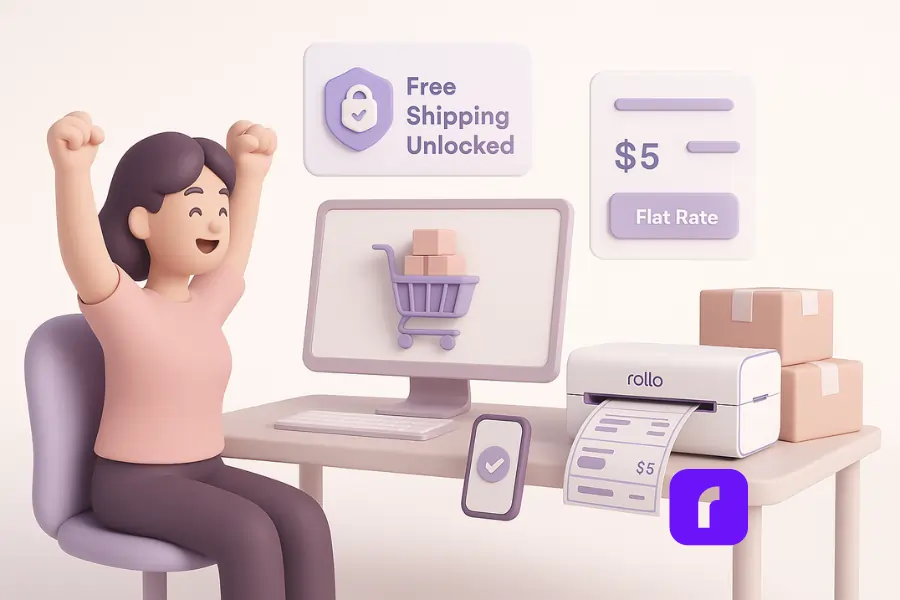
Free or flat-rate shipping reduces cart abandonment and lifts conversions. Extra costs at checkout are the top reason shoppers bail, so pricing clarity matters. Many customers prefer free shipping over pure speed and will add items to hit a threshold. Use rate shopping to fund the offer without crushing margins.
Why Free or Flat-Rate Shipping Works
Shoppers hate surprises. “Extra costs too high” leads global cart abandonments, so clear shipping costs build trust and customer satisfaction. Many buyers value free shipping more than fast shipping. Offer a simple, predictable cost to keep orders moving.
Common Pitfalls
Sellers copy a competitor’s “free shipping” without checking margins. Others set thresholds too low and lose money. Some hide fees until checkout, which drives bounce. Many customers will increase their cart to reach a well-set threshold, but only if you show it early.
How to Make It Profitable
- 🎯 Pick a smart threshold. Base it on AOV and shipping costs. Many buyers will add items to qualify.
- 📏 Use flat-rate for predictability. Simple pricing reduces friction on mobile.
- 💸 Fund the offer with savings. Use Rollo Ship to compare shipping rates, capture discounted ecommerce shipping rates, and pick the cheapest valid service for each order.
- 🔍 Test and tune. Try tiered thresholds by zone or product weight to protect margins during peak.
Set the price playbook now. Next, fix slow manual steps that waste time and raise ecommerce shipping costs.
Mistake #10 – Sticking to Manual, Time-Consuming Shipping Processes
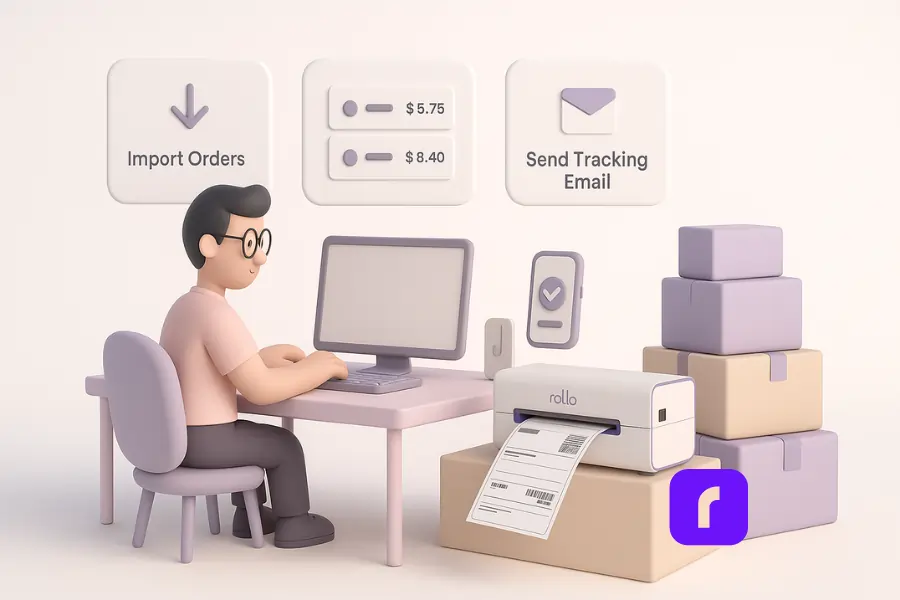
Manual workflows slow ecommerce shipping and create costly errors. Handwriting labels and retyping orders waste hours and miss pickups. Automation prints labels in seconds, compares carrier rates, and sends tracking updates automatically. Industry reports show automated labeling cuts handling time and often pays back within a year
Why Manual Processes Hold You Back
Manual steps multiply small delays. They also increase mislabels and address mistakes. That hurts delivery speed, raises support tickets, and chips away at customer satisfaction. You can offset some of these delays by offering customers compelling rates—see how to boost eCommerce sales with shipping discounts.
Common Manual Workflow Problems
- 🔄 Re-entering orders across apps
- ✍️ Handwriting labels and packing slips
- 🌐 Toggling between carrier websites
- 📦 Missed pickups and duplicate shipments
These issues raise labor costs and create uneven delivery times.
How to Automate Ecommerce Shipping and Save Time
Connect your store and sales channels to Rollo Ship. Import orders, rate-shop across shipping carriers, and print labels in a few clicks. Pair with a Rollo Wireless Label Printer for fast, smudge-free labels.
- ⚙️ Auto-apply carrier rules and service levels
- 📧 Trigger branded tracking emails after each scan
- 📊 Export metrics to track cost per order and on-time rate
Modern ecommerce shipping services help sellers save money by offering bulk rate discounts and automated label printing. Learn more about the benefits of modern shipping platforms in our guide to the truth about eCommerce shipping software.
Final Words
Fix these ten mistakes to make ecommerce shipping cheaper, faster, and more reliable. Clear delivery dates, right-sized packaging, and smarter carriers cut costs and boost customer satisfaction. Small businesses can compete with big retailers by adopting ecommerce shipping solutions that automate carrier selection and label creation. Connect your store to Rollo Ship and print with the Rollo Wireless Label Printer to ship smarter today.
Follow Rollo on:
Frequently Asked Questions About Ecommerce Shipping
📌 Q: What’s the cheapest way to ship ecommerce orders?
💭 A: The cheapest way to ship ecommerce orders is to compare shipping rates from multiple shipping carriers before you buy a label. For lightweight packages, USPS economy shipping is often cost-effective, while UPS and FedEx may offer better rates for heavier parcels. Using Rollo Ship’s pre-negotiated shipping rates can lower shipping costs and save money without sacrificing service quality.
📌 Q: How can I offer free shipping without losing profit?
💭 A: To offer free shipping sustainably, build shipping expenses into product pricing or set a minimum order value. You can also offer flat rate shipping for certain zones or use discounted shipping rates from your preferred shipping company. Many ecommerce stores combine economy shipping with free shipping offers to control costs while improving the customer experience.
📌 Q: Which carriers are best for small ecommerce businesses?
💭 A: The best shipping carriers for an ecommerce business depend on your shipping zones, package weight, and delivery speed needs. Major shipping carriers like USPS, UPS, and FedEx offer ground shipping, overnight shipping, and international shipping options. For local delivery, consider regional carriers for faster and cheaper service.
📌 Q: How do I compare carrier rates quickly?
💭 A: Use a shipping platform like Rollo Ship to compare real-time shipping rates from top shipping carriers. You can filter by shipping methods such as two day shipping, same day delivery, expedited shipping, or economy shipping. This approach ensures you select the best shipping solution for your customer’s location and delivery expectations.
📌 Q: How can automation improve my shipping process?
💭 A: Automated shipping reduces human error, speeds up the fulfillment process, and keeps customers informed throughout the delivery process. You can sync orders from your ecommerce platform or sales channels, print shipping labels instantly, and auto-update tracking. With automation, you can streamline multiple shipping options, improve shipping speed, and enhance the personalized delivery experience.
📌 Q: What should my ecommerce shipping strategy include?
💭 A: Your ecommerce shipping strategy should balance customer expectations, shipping costs, and shipping speed. Offer multiple shipping options—economy, flat rate, expedited, and same day delivery—so customers can choose their preferred delivery services. Factor in packaging costs, shipping insurance, and international shipments when creating your pricing model.
📌 Q: How can I reduce packaging and shipping expenses?
💭 A: Right-size your packaging to avoid dimensional weight charges and minimize packaging costs. Consolidate orders when possible, and use multiple fulfillment centers to ship products from the closest warehouse to the customer’s location. This reduces shipping expenses, shortens the delivery process, and improves the customer experience.
📌 Q: What’s the best shipping solution for Shopify stores and other ecommerce platforms?
💭 A: The best shipping solution for Shopify shipping, WooCommerce, or other ecommerce platforms is one that integrates directly with your sales channels. Look for shipping software that offers real-time carrier rate comparisons, automated label printing, and order tracking. Rollo Ship works with most ecommerce platforms to simplify the order fulfillment process.
📌 Q: When should I use freight shipping?
💭 A: Freight shipping is ideal for large, heavy, or bulk shipments that exceed parcel carrier limits. If you run an online business selling oversized items, freight can reduce costs per unit shipped. Always compare freight carriers for the best rates and delivery services in your shipping zone.
📌 Q: How do I handle international shipping and customs?
💭 A: For international shipments, complete customs forms accurately and declare product values honestly to avoid delays. Use a shipping company that offers customs-ready labels and real-time tracking for international shipping. Many ecommerce fulfillment providers offer discounted shipping rates for cross-border orders to help you save money.
